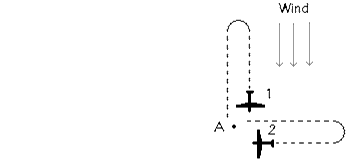Chapter 0-Page 0
FINALLY, CAN WE DISCOVER ABSOLUTE MOTION
First, we have to describe a certain effect they used in the ether experiment, and to do that, we'll switch to a different kind of aircraft. Suppose we have two airplanes, 1 and 2 shown below. Both planes fly at the same speed through the air and pass over point A at the same time (different altitudes so they don't meet unpleasantly). Plane 1 flies directly into a headwind for one hundred miles, circles, and returns to point A with a tailwind. Plane 2 flies for one hundred miles and back again, with the wind directly from the side.

Plane 1 has to first struggle directly into the headwind, and then the tailwind pushes it on the return trip. Plane 2 has to struggle against the wind by flying at a slight angle into the wind both directions. Which one will get back to A first? Surprisingly, plane 2 will because the return trip for plane 1 doesn't quite make up for the time spent going into the wind. You can use some math to prove this will happen, but perhaps do that some other time. We're busy right now.
An actual light experiment in 1887 used something like the object below. Two scientists, Michelson and Morley, mounted a light source (in one frequency) on a heavy, stone slab floating in mercury. They put a bunch of mirrors on the slab to reflect the light beam back and forth making the light travel as far as possible on the slab. They put another set of mirrors in the middle, so the beam also traveled at right angles for the same distance. They had a little telescope focused at the point where the lights cross after making the trip.
Chapter 0-Page 0